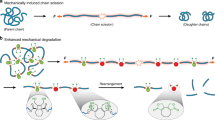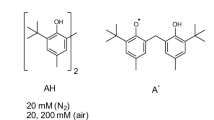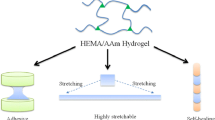Abstract
High shear stresses are known to trigger destructive bond-scission reactions in polymers. Recent work has shown that the same shear forces can be used to accelerate non-destructive reactions in mechanophores along polymer backbones, and it is demonstrated here that such mechanochemical reactions can be used to strengthen a polymer subjected to otherwise destructive shear forces. Polybutadiene was functionalized with dibromocyclopropane mechanophores, whose mechanical activation generates allylic bromides that are crosslinked in situ by nucleophilic substitution reactions with carboxylates. The crosslinking is activated efficiently by shear forces both in solvated systems and in bulk materials, and the resulting covalent polymer networks possess moduli that are orders-of-magnitude greater than those of the unactivated polymers. These molecular-level responses and their impact on polymer properties have implications for the design of materials that, like biological materials, actively remodel locally as a function of their physical environment.
This is a preview of subscription content, access via your institution
Access options
Subscribe to this journal
Receive 12 print issues and online access
$259.00 per year
only $21.58 per issue
Buy this article
- Purchase on Springer Link
- Instant access to full article PDF
Prices may be subject to local taxes which are calculated during checkout



Similar content being viewed by others
References
Odell, J. A. & Keller, A. Flow-induced chain fracture of isolated linear macromolecules in solution. J. Polym. Sci. B 24, 1889–1916 (1986).
Kudish, I. I., Airapetyan, R. G. & Covitch, M. J. Modeling of kinetics of stress-induced degradation of polymer additives in lubricants and viscosity loss. Tribol. Trans. 46, 1–10 (2003).
Zhurkov, S. N. & Korsukov, V. E. Atomic mechanism of fracture of solid polymers. J. Polym. Sci. B 12, 385–398 (1974).
Keckes, J. et al. Cell-wall recovery after irreversible deformation of wood. Nature Mater. 2, 810–814 (2003).
Watson, G. M. & Mire, P. Reorganization of actin during repair of hair bundle mechanoreceptors. J. Neurocytol. 30, 895–906 (2001).
Caruso, M. M. et al. Mechanically-induced chemical changes in polymeric materials. Chem. Rev. 109, 5755–5798 (2009).
Black, A. L., Lenhardt, J. M. & Craig, S. L. From molecular mechanochemistry to stress-responsive materials. J. Mater. Chem. 21, 1655–1663 (2011).
Hickenboth, C. R. et al. Biasing reaction pathways with mechanical force. Nature 446, 423–427 (2007).
Lenhardt, J. M. et al. Trapping a diradical transition state by mechanochemical polymer extension. Science 329, 1057–1060 (2010).
Wu, D., Lenhardt, J. M., Black, A. L., Akhremitchev, B. B. & Craig, S. L. Molecular stress relief through a force-induced irreversible extension in polymer contour length. J. Am. Chem. Soc. 132, 15936–15938 (2010).
Park, I. & Sheiko, S. S. Molecular tensile testing machines: breaking a specific covalent bond by adsorption-induced tension in brushlike macromolecules. Macromolecules 42, 1805–1807 (2009).
Wiita, A. P., Ainavarapu, S. R. K., Huang, H. H. & Fernandez, J. M. Force-dependent chemical kinetics of disulfide bond reduction observed with single-molecule techniques. Proc. Natl Acad. Sci. USA 103, 7222–7227 (2006).
Brantley, J. N., Wiggins, K. M. & Bielawski, C. W. Unclicking the click: mechanically facilitated 1,3-dipolar cycloreversions. Science 333, 1606–1609 (2011).
Black, A. L., Orlicki, J. A. & Craig, S. L. Mechanochemically triggered bond formation in solid-state polymers. J. Mater. Chem. 21, 8460–8465 (2011).
Berkowski, K. L., Potisek, S. L., Hickenboth, C. R. & Moore, J. S. Ultrasound-induced site-specific cleavage of azo-functionalized poly(ethylene glycol). Macromolecules 38, 8975–8978 (2005).
Karthikeyan, S., Potisek, S. L., Piermattei, A. & Sijbesma, R. P. Highly efficient mechanochemical scission of silver–carbene coordination polymers. J. Am. Chem. Soc. 130, 14968–14969 (2008).
Kryger, M. J. et al. Masked cyanoacrylates unveiled by mechanical force. J. Am. Chem. Soc. 132, 4558–4559 (2010).
Paulusse, J. M. J. & Sijbesma, R. P. Reversible mechanochemistry of a Pd(II) coordination polymer. Angew. Chem. Int. Ed. 43, 4460–462 (2004).
Yang, Q-Z. et al. A molecular force probe. Nature Nanotech. 4, 302–306 (2009).
Klukovich, H. M. et al. Tension trapping of carbonyl ylides facilitated by a change in polymer backbone. J. Am. Chem. Soc. 134, 9577–9580 (2012).
Klukovich, H. M., Kouznetsova, T. B., Kean, Z. S., Lenhardt, J. M. & Craig, S. L. A backbone lever-arm effect enhances polymer mechanochemistry. Nature Chem. 5, 110–114 (2013).
Davis, D. A. et al. Force-induced activation of covalent bonds in mechanoresponsive polymeric materials. Nature 459, 68–71 (2009).
Crenshaw, B. R. et al. Deformation induced color changes in mechanochromic polyethylene blends. Macromolecules 40, 2400–2408 (2007).
Chen, Y. et al. Mechanically induced chemiluminescence from polymers incorporating a 1,2-dioxetane unit in the main chain. Nature Chem. 4, 559–562 (2012).
Kean, Z. S. & Craig, S. L. Mechanochemical remodeling of synthetic polymers. Polymer 53, 1035–1048 (2012).
Oliver, W. C. & Pharr, G. M. An improved technique for determining hardness and elastic modulus using load and displacement sensing indentation experiments. J. Mater. Res. 7, 1564–1583 (1992).
Paulusse, J. M. J. & Sijbesma, R. P. Ultrasound in polymer chemistry: revival of an established technique. J. Polym. Sci. Polym. Chem. 44, 5445–5453 (2006).
May, P. A. & Moore, J. S. Polymer mechanochemistry: techniques to generate molecular force via elongational flows. Chem. Soc. Rev. http://dx.doi.org/10.1039/c2cs35463b (2013).
Basedow, A. M. & Ebert, K. H. in Advances in Polymer Science Vol. 22 (eds Cantow, H-J. et al.) 83–148 (Springer, 1977).
Nguyen, T. Q., Liang, Q. Z. & Kausch, H. H. Kinetics of ultrasonic and transient elongational flow degradation: a comparative study. Polymer 38, 3783–3793 (1997).
Schosseler, F., Benoit, H., Grubisic-Gallot, Z., Strazielle, C. & Leibler, L. Gelation process by size-exclusion chromatography coupled with light scattering. Macromolecules 22, 400–410 (1989).
Francis, R. S., Patterson, G. D. & Kim, S. H. Liquid-like structure of polymer solutions near the overlap concentration. J. Polym. Sci. Polym. Phys. 44, 703–710 (2005).
Naota, T. & Koori, H. Molecules that assemble by sound: an application to the instant gelation of stable organic fluids J. Am. Chem. Soc. 127, 9324–9325 (2005).
Carnall, J. M. A. et al. Mechanosensitive self-replication driven by self-organization. Science 327, 1502–1506 (2010).
Carey, B. J., Patra, P. K., Ci, L., Silva, G. G. & Ajayan, P. M. Observation of dynamic strain hardening in polymer nanocomposites. ACS Nano 5, 2715–2722 (2011).
Acknowledgements
This material is based on work supported by the US Army Research Laboratory and the Army Research Office under Grant W911NF-07-1-0409 and the National Science Foundation (DMR-1122483). A.L.B.R. was supported by a Department of Defense Science, Mathematics and Research for Transformation Fellowship and Z.S.K. by a National Institutes of Health NIGMS Biotechnology Predoctoral Training Grant (T32GM8555).
Author information
Authors and Affiliations
Contributions
A.L.B.R. and S.L.C. conceived and designed the experiments. A.L.B.R. and Z.S.K. performed the synthesis, J.A.O. contributed extrusion equipment and analysed that data with A.L.B.R. A.L.B.R. and S.M.E. performed the shear experiments. W.E.K. contributed the nanoindentation tools and M.C. performed the nanoindentation experiments and analysed that data. A.L.B.R., Z.S.K. and S.L C. analysed the data and co-wrote the paper.
Corresponding author
Ethics declarations
Competing interests
The authors declare no competing financial interests.
Supplementary information
Supplementary information
Supplementary information (PDF 4280 kb)
Rights and permissions
About this article
Cite this article
Ramirez, A., Kean, Z., Orlicki, J. et al. Mechanochemical strengthening of a synthetic polymer in response to typically destructive shear forces. Nature Chem 5, 757–761 (2013). https://doi.org/10.1038/nchem.1720
Received:
Accepted:
Published:
Issue Date:
DOI: https://doi.org/10.1038/nchem.1720
This article is cited by
-
Leveraging mechanochemistry for sustainable polymer degradation
Polymer Journal (2024)
-
Bioinspired nanocomposites with self-adaptive mechanical properties
Nano Research (2024)
-
Mechanically gated formation of donor–acceptor Stenhouse adducts enabling mechanochemical multicolour soft lithography
Nature Chemistry (2023)
-
Wide-ranging Force Responsive Composites based on 1,2-Dioxetane and ZnS as Luminescent Probes in Polyurethanes
Chinese Journal of Polymer Science (2023)
-
A Modern Look at Spiropyrans: From Single Molecules to Smart Materials
Topics in Current Chemistry (2023)



